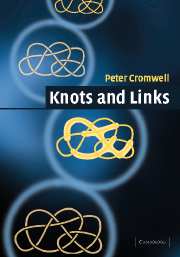Book contents
- Frontmatter
- Contents
- Preface
- Notation
- 1 Introduction
- 2 A Topologist's Toolkit
- 3 Link Diagrams
- 4 Constructions and Decompositions of Links
- 5 Spanning Surfaces and Genus
- 6 Matrix Invariants
- 7 The Alexander–Conway Polynomial
- 8 Rational Tangles
- 9 More Polynomials
- 10 Closed Braids and Arc Presentations
- Appendix A Knot Diagrams
- Appendix B Numerical Invariants
- Appendix C Properties
- Appendix D Polynomials
- Appendix E Polygon Coordinates
- Appendix F Family Properties
- Bibliography
- Index
5 - Spanning Surfaces and Genus
Published online by Cambridge University Press: 05 June 2012
- Frontmatter
- Contents
- Preface
- Notation
- 1 Introduction
- 2 A Topologist's Toolkit
- 3 Link Diagrams
- 4 Constructions and Decompositions of Links
- 5 Spanning Surfaces and Genus
- 6 Matrix Invariants
- 7 The Alexander–Conway Polynomial
- 8 Rational Tangles
- 9 More Polynomials
- 10 Closed Braids and Arc Presentations
- Appendix A Knot Diagrams
- Appendix B Numerical Invariants
- Appendix C Properties
- Appendix D Polynomials
- Appendix E Polygon Coordinates
- Appendix F Family Properties
- Bibliography
- Index
Summary
In this chapter we shall see that the topology of knots and links is closely related to properties of surfaces. A surface F spans a link L if its boundary ∂F is ambient isotopic to L.
Definition 5.0.1 (link genus). The genus of an oriented link L is the minimum genus of any connected orientable surface that spans L. The genus of an unoriented link is the minimum taken over all possible choices of orientation. We denote the genus of L by g(L).
There are several observations that arise from this definition. First, it is not obvious that genus is well-defined: does every link bound an orientable surface? In the exercises at the end of Chapter 3 you constructed spanning surfaces from chessboard colourings, but these are not necessarily orientable.
Second, genus is yet another invariant defined by minimising a geometric property over all possibilities and therefore it is difficult to calculate in general. Any knot with genus zero is spanned by a disc and hence is the trivial knot. A genus-1 surface spanning a non-trivial knot must be minimal. Proving that any other surface is minimal can be very hard. In Chapter 7 we shall see that link genus can be related to a polynomial invariant which gives a lower bound. We can get an upper bound by construction, therefore some classes of surface can be proved to be minimal.
- Type
- Chapter
- Information
- Knots and Links , pp. 102 - 128Publisher: Cambridge University PressPrint publication year: 2004



